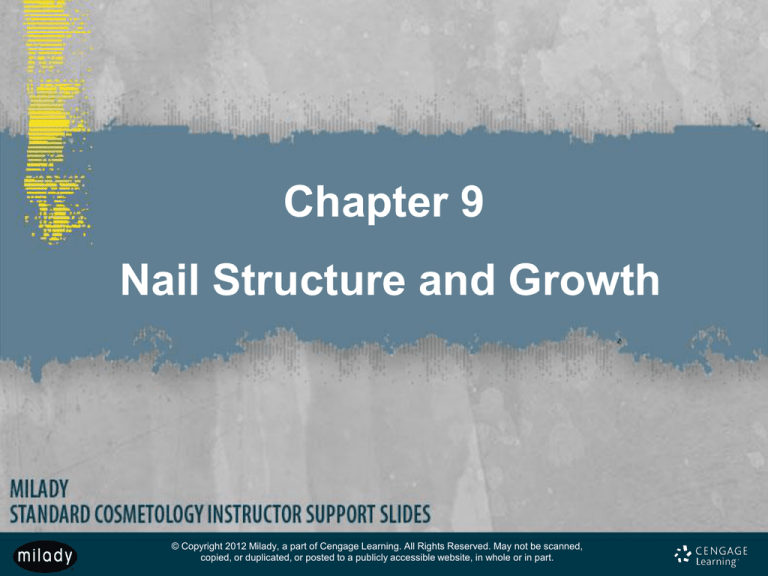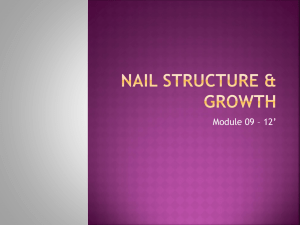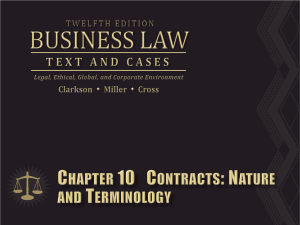
Chapter 9
Nail Structure and Growth
© Copyright 2012 Milady, a part of Cengage Learning. All Rights Reserved. May not be scanned,
copied, or duplicated, or posted to a publicly accessible website, in whole or in part.
“Knowing yourself is the beginning of all
wisdom.”
– Aristotle
© Copyright 2012 Milady, a part of Cengage Learning. All Rights Reserved. May not be scanned,
copied, or duplicated, or posted to a publicly accessible website, in whole or in part.
Objectives
• Describe the structure and composition of nails.
• Discuss how nails grow.
© Copyright 2012 Milady, a part of Cengage Learning. All Rights Reserved. May not be scanned,
copied, or duplicated, or posted to a publicly accessible website, in whole or in part.
The Nail
• An appendage of the skin; the horny, translucent,
protective plate that protects the tips of the fingers and
toes. It is part of the integumentary system.
• Onyx –the technical term for nail
© Copyright 2012 Milady, a part of Cengage Learning. All Rights Reserved. May not be scanned,
copied, or duplicated, or posted to a publicly accessible website, in whole or in part.
Composition
• Keratin
• Nail porosity
– 15 to 25 percent water.
– Water affects flexibility.
– Oil-based conditioner reduces water loss.
• Healthy nail
© Copyright 2012 Milady, a part of Cengage Learning. All Rights Reserved. May not be scanned,
copied, or duplicated, or posted to a publicly accessible website, in whole or in part.
Nail Anatomy: Major Parts
• Nail plate (nail body)
• Cuticle
• Free edge
• Eponychium
• Nail bed
• Hyponychium
• Matrix bed (nail root)
• Specialized ligaments
• Lunula
• Nail folds
© Copyright 2012 Milady, a part of Cengage Learning. All Rights Reserved. May not be scanned,
copied, or duplicated, or posted to a publicly accessible website, in whole or in part.
Nail Plate
• The most visible and functional part of the nail unit
• Rests on/slides across nail bed
• Formed by matrix cells
• Constructed in layers
• Free edge extends over tips of finger or toe
© Copyright 2012 Milady, a part of Cengage Learning. All Rights Reserved. May not be scanned,
copied, or duplicated, or posted to a publicly accessible website, in whole or in part.
Nail Bed
• Skin supporting nail plate as it grows toward free edge
• Extends from lunula to just before free edge
• Attached to nail plate
• Supplied with many nerves
© Copyright 2012 Milady, a part of Cengage Learning. All Rights Reserved. May not be scanned,
copied, or duplicated, or posted to a publicly accessible website, in whole or in part.
Nail Structure
© Copyright 2012 Milady, a part of Cengage Learning. All Rights Reserved. May not be scanned,
copied, or duplicated, or posted to a publicly accessible website, in whole or in part.
Matrix Bed
• Where nail is formed
• Composed of matrix cells that produce nail plate
• Contains nerves, lymph, blood vessels to nourish nails
• Extends from under nail fold at base of nail plate
• Injury to matrix or poor health affects nail growth
© Copyright 2012 Milady, a part of Cengage Learning. All Rights Reserved. May not be scanned,
copied, or duplicated, or posted to a publicly accessible website, in whole or in part.
Lunula
• Visible part of matrix
• Whitish, half-moon shape at base of nail
• Color caused by reflection of light off matrix surface.
• Some are hidden under eponychium.
© Copyright 2012 Milady, a part of Cengage Learning. All Rights Reserved. May not be scanned,
copied, or duplicated, or posted to a publicly accessible website, in whole or in part.
Cuticle
• Dead, colorless tissue attached to nail plate from
underside of skin that lies above natural nail plate
• Loose and flexible; difficult to remove from nail plate
• Seals area against foreign material and microorganisms
• Helps prevent injury and infection
© Copyright 2012 Milady, a part of Cengage Learning. All Rights Reserved. May not be scanned,
copied, or duplicated, or posted to a publicly accessible website, in whole or in part.
Eponychium
• The living skin at base of nail plate covering matrix
• Cannot be trimmed or cut by nail technician
© Copyright 2012 Milady, a part of Cengage Learning. All Rights Reserved. May not be scanned,
copied, or duplicated, or posted to a publicly accessible website, in whole or in part.
Hyponychium
• The slightly thickened skin that lies between the fingertip
and the free edge
• Protective barrier that seals the free edge, preventing
external moisture, bacteria, or fungi from getting under
the nail
© Copyright 2012 Milady, a part of Cengage Learning. All Rights Reserved. May not be scanned,
copied, or duplicated, or posted to a publicly accessible website, in whole or in part.
Specialized Ligaments
• Tough bands of fibrous tissue that connect bones or hold
an organ in place
• Attach the nail bed and matrix bed to underlying bone
• Located at base of matrix and around edges of nail bed
© Copyright 2012 Milady, a part of Cengage Learning. All Rights Reserved. May not be scanned,
copied, or duplicated, or posted to a publicly accessible website, in whole or in part.
Nail Folds
• Folds of normal skin surrounding nail plate
• Form nail grooves on which the nail moves as it grows
© Copyright 2012 Milady, a part of Cengage Learning. All Rights Reserved. May not be scanned,
copied, or duplicated, or posted to a publicly accessible website, in whole or in part.
Nail Growth Process
• Growth is affected by nutrition, general health, and
exercise.
• Nails grow forward, starting at matrix and extending over
fingertip.
• Nails grow in a variety of shapes.
• Average growth is 1/10 of an inch per month.
• Growth is faster in summer than winter.
• Children’s nails grow faster than adults’ nails.
© Copyright 2012 Milady, a part of Cengage Learning. All Rights Reserved. May not be scanned,
copied, or duplicated, or posted to a publicly accessible website, in whole or in part.
Nail Growth Process (continued)
•
•
•
•
Middle fingernail grows fastest.
Thumbnail grows slowest.
Toenails grow slower than fingernails.
Nails are not shed automatically like hair is.
© Copyright 2012 Milady, a part of Cengage Learning. All Rights Reserved. May not be scanned,
copied, or duplicated, or posted to a publicly accessible website, in whole or in part.
Nail Malformation
• Disease, injury, or infection can affect the formation of
nails. If the matrix remains in good condition, a normal
fingernail will be replaced in 4 to 6 months, a toenail in 9
to 12 months.
© Copyright 2012 Milady, a part of Cengage Learning. All Rights Reserved. May not be scanned,
copied, or duplicated, or posted to a publicly accessible website, in whole or in part.
Summary and Review
• What is the technical term for the nail?
• What protein is in the nail plate?
• Describe the appearance of a normal, healthy nail.
• Name the basic parts of the nail unit.
• Explain the difference between the nail plate and the nail
bed.
© Copyright 2012 Milady, a part of Cengage Learning. All Rights Reserved. May not be scanned,
copied, or duplicated, or posted to a publicly accessible website, in whole or in part.
Summary and Review (continued)
• What part of the nail unit contains the nerves, lymph, and
blood vessels?
• What is the difference between the cuticle and the
eponychium?
• Why are cosmetologists not allowed to cut the skin
around the base of the nail plate?
• What three things can affect the growth of the nail plate?
© Copyright 2012 Milady, a part of Cengage Learning. All Rights Reserved. May not be scanned,
copied, or duplicated, or posted to a publicly accessible website, in whole or in part.
Congratulations!
You have completed one unit of study
toward course completion.
© Copyright 2012 Milady, a part of Cengage Learning. All Rights Reserved. May not be scanned,
copied, or duplicated, or posted to a publicly accessible website, in whole or in part.










